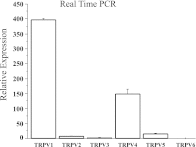HCl-induced and ATP-dependent upregulation of TRPV1 receptor expression and cytokine production by human esophageal epithelial cells
- PMID: 22790593
- PMCID: PMC3468560
- DOI: 10.1152/ajpgi.00097.2012
HCl-induced and ATP-dependent upregulation of TRPV1 receptor expression and cytokine production by human esophageal epithelial cells
Abstract
The pathogenesis of gastroesophageal reflux disease (GERD) remains elusive, but recent evidence suggests that early secretion of inflammatory cytokines and chemokines by the mucosa leads to influx of immune cells followed by tissue damage. We previously showed that exposure of esophageal mucosa to HCl causes ATP release, resulting in activation of acetyl-CoA:1-O-alkyl-sn-glycero-3-phosphocholine acetyltransferase (lyso-PAF AT), the enzyme responsible for the production of platelet-activating factor (PAF). In addition, HCl causes release of IL-8 from the esophageal mucosa. We demonstrate that esophageal epithelial cells secrete proinflammatory mediators in response to HCl and that this response is mediated by ATP. Monolayers of the human esophageal epithelial cell line HET-1A were exposed to acidified cell culture medium (pH 5) for 12 min, a total of seven times over 48 h, to simulate the recurrent acid exposure clinically occurring in GERD. HCl upregulated mRNA and protein expression for the acid-sensing transient receptor potential cation channel, subfamily vanilloid member 1 (TRPV1), lyso-PAF AT, IL-8, eotaxin-1, -2, and -3, macrophage inflammatory protein-1α, and monocyte chemoattractant protein-1. The chemokine profile secreted by HET-1A cells in response to repeated HCl exposure parallels similar findings in erosive esophagitis patients. In HET-1A cells, the TRPV1 agonist capsaicin reproduced these findings for mRNA of the inflammatory mediators lyso-PAF AT, IL-8, and eotaxin-1. These effects were blocked by the TRPV1 antagonists iodoresiniferatoxin and JNJ-17203212. These effects were imitated by direct application of ATP and blocked by the nonselective ATP antagonist suramin. We conclude that HCl/TRPV-induced ATP release upregulated secretion of various chemoattractants by esophageal epithelial cells. These chemoattractants are selective for leukocyte subsets involved in acute inflammatory responses and allergic inflammation. The data support the validity of HET-1A cells as a model of the response of the human esophageal mucosa in GERD.
Figures














Similar articles
-
ATP: a mediator for HCl-induced TRPV1 activation in esophageal mucosa.Am J Physiol Gastrointest Liver Physiol. 2011 Dec;301(6):G1075-82. doi: 10.1152/ajpgi.00336.2011. Epub 2011 Sep 29. Am J Physiol Gastrointest Liver Physiol. 2011. PMID: 21960521 Free PMC article.
-
HCl-activated neural and epithelial vanilloid receptors (TRPV1) in cat esophageal mucosa.Am J Physiol Gastrointest Liver Physiol. 2009 Jul;297(1):G135-43. doi: 10.1152/ajpgi.90386.2008. Epub 2009 Apr 23. Am J Physiol Gastrointest Liver Physiol. 2009. PMID: 19389802 Free PMC article.
-
Signaling in TRPV1-induced platelet activating factor (PAF) in human esophageal epithelial cells.Am J Physiol Gastrointest Liver Physiol. 2010 Feb;298(2):G233-40. doi: 10.1152/ajpgi.00409.2009. Epub 2009 Dec 3. Am J Physiol Gastrointest Liver Physiol. 2010. PMID: 19959817 Free PMC article.
-
Physiological and Pathological Significance of Esophageal TRP Channels: Special Focus on TRPV4 in Esophageal Epithelial Cells.Int J Mol Sci. 2022 Apr 20;23(9):4550. doi: 10.3390/ijms23094550. Int J Mol Sci. 2022. PMID: 35562940 Free PMC article. Review.
-
[Pro-inflammatory chemokine IL-8 in gastroesophageal reflux disease].Nihon Rinsho. 2004 Aug;62(8):1447-53. Nihon Rinsho. 2004. PMID: 15344533 Review. Japanese.
Cited by
-
TRPV1 Hyperfunction Involved in Uremic Toxin Indoxyl Sulfate-Mediated Renal Tubular Damage.Int J Mol Sci. 2020 Aug 27;21(17):6212. doi: 10.3390/ijms21176212. Int J Mol Sci. 2020. PMID: 32867359 Free PMC article.
-
TRPV1 Hyperfunction Contributes to Renal Inflammation in Oxalate Nephropathy.Int J Mol Sci. 2021 Jun 8;22(12):6204. doi: 10.3390/ijms22126204. Int J Mol Sci. 2021. PMID: 34201387 Free PMC article.
-
Development and dysfunction of structural cells in eosinophilic esophagitis.J Allergy Clin Immunol. 2024 Jun;153(6):1485-1499. doi: 10.1016/j.jaci.2024.04.006. J Allergy Clin Immunol. 2024. PMID: 38849184 Free PMC article. Review.
-
Acid burn or cytokine sizzle in the pathogenesis of heartburn?J Gastroenterol Hepatol. 2013 Mar;28(3):385-7. doi: 10.1111/jgh.12103. J Gastroenterol Hepatol. 2013. PMID: 23441717 Free PMC article. No abstract available.
-
TRPV1 Channel in Human Eosinophils: Functional Expression and Inflammatory Modulation.Int J Mol Sci. 2024 Feb 5;25(3):1922. doi: 10.3390/ijms25031922. Int J Mol Sci. 2024. PMID: 38339203 Free PMC article.
References
-
- Abouheif E, Akam M, Dickinson WJ, Holland PW, Meyer A, Patel NH, Raff RA, Roth VL, Wray GA. Homology and developmental genes. Trends Genet 13: 432–433, 1997 - PubMed
-
- Azpiroz F, Baudet JS, Benages A, Canga F, Carrasco J, Ciriza C, Cucala M, Dominguez E, Faro V, Garrigues V, Giganto F, Herrerias JM, Iglesias J, Lacima G, Lopez P, Llabres M, Mearin F, Minguez M, Mones J, Mora F, Munoz C, Perez de la Serna J, Ponce J, Rodriguez-Tellez M, Romero MJ, Ruiz de Leon A, Ruiz-Cabello M, Sanchez-Gey S, Sanchiz V, Serra J, Sevilla MC, Sopena F, Soria MJ. Normal values in ambulatory oesophageal pH monitoring at two levels in Spain. Rev Esp Enferm Dig 102: 406–412, 2010 - PubMed
-
- Baggiolini M, Loetscher P, Moser B. Interleukin-8 and the chemokine family. Int J Immunopharmacol 17: 103–108, 1995 - PubMed
-
- Basseri B, Levy M, Wang HL, Shaye OA, Pimentel M, Soffer EE, Conklin JL. Redefining the role of lymphocytes in gastroesophageal reflux disease and eosinophilic esophagitis. Dis Esophagus 23: 368–376, 2010 - PubMed
-
- Bhattacharya A, Scott BP, Nasser N, Ao H, Maher MP, Dubin AE, Swanson DM, Shankley NP, Wickenden AD, Chaplan SR. Pharmacology and antitussive efficacy of 4-(3-trifluoromethyl-pyridin-2-yl)-piperazine-1-carboxylic acid (5-trifluoromethyl-pyridin-2-yl)-amide (JNJ17203212), a transient receptor potential vanilloid 1 antagonist in guinea pigs. J Pharmacol Exp Ther 323: 665–674, 2007 - PubMed
Publication types
MeSH terms
Substances
Grants and funding
LinkOut - more resources
Full Text Sources
Medical
Research Materials

